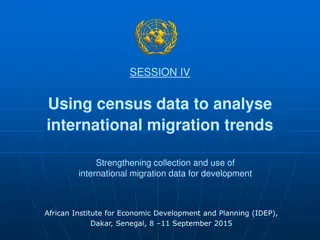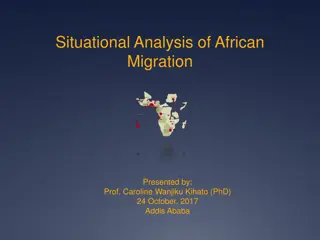International Cooperation in Migration Management - Theoretical Underpinnings and Challenges
Understanding the importance and difficulty of international cooperation in migration management, this content explores regime theory, global governance aspects, and historical efforts towards migration global governance post various world wars. It highlights the complexities arising from the intersection of migration with transnational issues like development, security, and environmental change.
Uploaded on Nov 26, 2024 | 1 Views
Download Presentation

Please find below an Image/Link to download the presentation.
The content on the website is provided AS IS for your information and personal use only. It may not be sold, licensed, or shared on other websites without obtaining consent from the author. Download presentation by click this link. If you encounter any issues during the download, it is possible that the publisher has removed the file from their server.
E N D
Presentation Transcript
International Cooperation in Migration Management Susan Martin Donald G. Herzberg Professor Emerita of International Migration March 2017
Theoretical Underpinnings Regime Theory Norms, Principles, Rules and Decision-Making Procedures (Krasner 1983) Focus on three aspects of global governance International norms and legal framework Institutional arrangements within global system Inter-state cooperation
Why Is International Cooperation Important ? Size and complexity of migration flows make unilateral policies difficult to implement and enforce International/internal Voluntary/forced Temporary/permanent Intersection of migration with such transnational issues as development, poverty reduction, trade Intersection of migration and security, in context of conflict, terrorism and organized crime Intersection of migration and environmental change Growth in transnational communities
Why is International Cooperation So Difficult? Responsibility to control borders, admit immigrants, and provide access to citizenship are quintessential components of sovereignty Lack of agreement on impacts of immigration and emigration Asymmetry between emigration and immigration countries Difficulty of harmonizing policies and approaches even among like-minded states Lack of legal and institutional frameworks for addressing full range of migration issues in cooperative manner
Efforts at Migration Global Governance Migration in context of geo-political change Post World War I Post World War II Post Cold War Migration at the nexus of other transnational issues Development Security Environmental Change
Post World War I Institutional arrangements defined International Labor Organization Passport Conference League of Nations High Commissioner for Refugees Successes in the 1920s Agreement on need for labor standards Agreement on passport standards Assistance to Russian refugees, those displaced by Treaty of Lausanne, etc. Nansen passport Failures in the 1930s-early 1940s No agreement on ILO Labor Convention Evian and Bermuda conferences on refugees
Post World War II Problem of Refugees UN Relief and Rehabilitation Administration International Refugee Organization UN High Commissioner for Refugees UN Convention Relating to the Status of Refugees International Labor Organization 1944 Philadelphia Labor Conference (new role for ILO re: UN and migration) 1949 Migration for Employment Convention (equality of treatment; few parties to convention; model agreement more useful Intergovernmental Committee for European Migration Service agency to expand immigration opportunities Outside of UN (becomes International Organization for Migration)
Post Cold War Regional Plans of Action (SE Asia, CIS, CIREFCA) UN Migrant Workers Convention (1990) UN Conference on Population and Development (1994) Regional Consultative Processes (e.g.) Berne Initiative (2001) Doyle Report (2004) Global Commission on International Migration (2005)
Norms and Legal Frameworks Strongest for refugees Binding international law with robust ratifications Growing for trafficking and smuggling Protocols to Convention on Transnational Organized Crime well ratified Stronger on prosecution than on prevention or protection Weak for labor migration ILO Conventions and 1990 UN Convention Relatively few ratifications, particularly from destination countries Limited in trade context Trade in services (natural persons)
Institutional Reform Global Migration Group (2006-) Special Representative of Secretary General on International Migration High Level Dialogue on Migration and Development (2006 and 2013) Entry of International Organization for Migration into UN as UN Migration Agency UN High Level Meeting on Large Scale Movements of Refugees and Migrants (September 2016) Global compact on international migrants (to be negotiated by 2018) Global compact on refugees (ditto)
Inter-State Cooperation Global Forum on Migration and Development Outgrowth of 2006 HLD Non-binding, consultative process Integration of migration issues into post 2015 development agenda and other international negotiations Mini-Multilateralism Nansen Initiative/Platform for Disaster Displacement Migrants in Countries in Crisis Initiative
Whats Next? Continuing efforts at confidence- and capacity-building through GFMD More mini-multilateral efforts to establish consensus on norms and practical applications (e.g., guidelines and effective practices to protect vulnerable migrants) Strengthening of core institutions (UNHCR, IOM and GMG)























